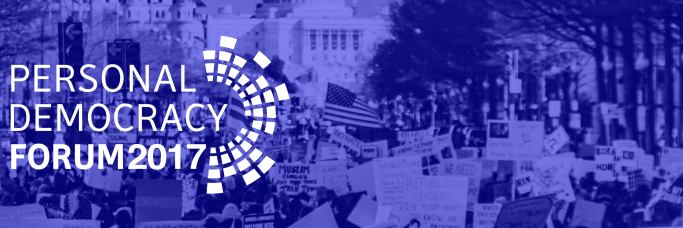
New models for citizens to take media into their own hands on display at #PDF17
A shortlist of media innovations with potentially long reach, spotlighted during the 2017 Personal Democracy Forum, included an upcoming news site whose subscribers will help dictate what’s covered and a planned strategic expansion of Native American efforts to shape headlines about their concerns.
Hosted by Civic Hall, the New York conference drew a global roster of artists, activists, politicians, journalists, technologists and other change-makers bent on enlarging the public discourse and public understanding of the mother lode of information online and elsewhere. This, the conferees said, at a time when disinformation is deliberately spread and often unchecked.
“One of my favorite books is ‘How to Lie With Statistics’,” journalist, author and former health insurance communications executive-turned-whistleblower Wendell Potter told listeners at a Knight Foundation-sponsored conference panel on media innovation.
Potter, who began his professional life in a Tennessee newsroom, founded the forthcoming nonprofit, reader-funded Tarbell news site—named after 19th Century journalist Ida Tarbell, who investigated and inveighed against crony-capitalism—following stints at Humana and Cigna where he became convinced that those health insurance giants were undermining health consumers and health care markets.
“Any set of data can be used to make a point … Part of this goes back to the question of literacy,” continued Potter, whose site will probe Washington lobbyists and other special interest groups. “How do you help people understand the data?”
Ramping up that understanding among average citizens’ goes hand-in-hand with letting them dictate what gets funneled through the 24/7 news cycle and other informational spheres, suggested Jay Rosen, a media critic and New York University journalism professor.
With Knight and Democracy Fund grants, Rosen launched the Membership Puzzle Project. It’s modeled after De Correspondent, which was founded and financed through crowd-funding in 2013, Rosen said, “by refugees from legacy media in the Netherlands.” As the largest subscription-based, ad-free news organization of its kind in that country, it has 56,000 member-subscribers, paying $65 a year in dues, and a $3.5-million editorial budget supported by two other, smaller revenue streams.
Its 29 full-time correspondents define their own news coverage beats and choose their own reporting projects. They do so alongside a complement of 75 paid freelancers, Rosen said, and “are required to interact with the readers and draw knowledge from the community of members” with whom they must spend 45 to 50 percent of correspondent work time.
“There’s no clickbait, no misleading headlines, no audience targets,” Rosen said. “They can create a deep bond of trust with their users.”
Rosen said NYU partnered with De Correspondent believing it could prove that such a collaborative, membership-driven model is sustainable and replicable.
“How can these two worlds teach each other?” he asked, during the panel discussion. “Hopefully, the research I’m doing will make it more likely that they can succeed.”
Citizen input also can make a difference elsewhere along the mediascape, conferees said.
It took nine months, for example, for mainstream news organizations to grasp the newsworthiness of Sioux Indian water-preservationists’ protests against a commercial oil pipeline through the Standing Rock Reservation in North and South Dakota, said Josue Rivas, a documentary photographer whose Standing Rock photojournalism has been shown around the world.
It’s unfortunate, he said, during a panel on “decolonizing technology and media,” that it took this nation’s big newsrooms so long, relatively speaking, to recognize that Standing Rock was a big story. The good thing, though, was that Native Americans who’d been documenting what was transpiring on their cellphones and posting what they recorded online learned the difference they could make in shaping their own, unfiltered message. That’s critical for what is one of the most marginalized of the nation’s marginalized groups, he said.
In similar ways, other everyday Americans can use what is a rich lode of information in this internet age—of raw data that is and isn’t curated—to shape public discourse and put that data to use in their daily lives and the lives of their communities, said Jake Porway, a Knight grantee and founder and executive director of DataKind. He was moderating a panel on “the role of data-science in a post-fact world.”
Natalie Evans Harris, a former senior advisor to President Obama’s chief technology officer and a National Security Agency manager told that panel’s audience that disinformation goes un-debunked partly because trained scientists have done too little to show the untrained layperson how to harness and parse data that can, in fact, be parsed by everyday people.
“We haven’t been explaining where the data come from without it sounding all techy and wonky. We have to figure out data literacy in a way that resonates with the artist and the teacher,” she said. “Data science isn’t just for computer scientists and the statisticians.”
Said Zara Rahman, co-founder of InformTransform, who was on the same panel: “Citizen-generated data,” “should say, ‘This is the issue … It’s a way of shining a spotlight and advocating for programs.”
Katti Gray is a freelance writer and editor. For more, visit kattigray.com and follow her on Twitter @KattiGray.
Recent Content
-
Journalismarticle ·
-
Journalismarticle ·
-
Journalismarticle ·


